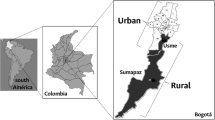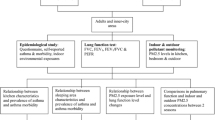Summary
We evaluated the effects of some indoor environmental factors in a non smoking subsample (n=381, age 8–19 years) of the general population living in the Po River Delta. Each subject completed an interviewer-administered standardized questionnaire on respiratory symptoms and risk factors. Acceptable maneuvers of forced vital capacity and slope of alveolar plateau of nitrogen were obtained in 96% and 59% of the subjects, respectively. In the houses there were more frequently natural gas for cooking (86%) than bottled gas (14%) and central heating (82%) than stove (18%). As regards passive smoking exposure, 18% of subjects had both parents smoking, 50% had one parent smoking. Significantly higher prevalence rates of wheeze, dyspnea, diagnosis of asthma were found in subjects of both sexes using bottled gas for cooking in comparison to those using natural gas, when also exposed to passive smoking. An insignificant trend towards higher symptom rates was shown by those using stove, instead of central heating. Lung function was affected only in females: those with both parents smoking had reduced forced expirograms, those with bottled gas for cooking or stove for heating had a decreased peak expiratory flow. Interactions of stove and passive smoking on peak expiratory flow and on slope of alveolar plateau were statistically significant. These findings confirm the mild adverse respiratory effects of certain home environment factors shown by other epidemiologic surveys in North Europe and in the USA. They have been a basis for the implementation, under the auspices of National Research Council and Electric Energy Authority, of future specific studies in which continuous monitoring of indoor pollutants and repeated recording of symptoms and lung function in North and Central Italy will be performed.
Similar content being viewed by others
References
Brunekreff B., Dockery D.W., Speizer F.E., Ware J.H., Spengler J.D., Ferris B.G., (1989) —Home dampness and respiratory morbidity in children. Am. Rev. Respir. Dis.,140:1363–1367.
Carmignani G., Paoletti P., Mammini U., Carrozzi L., Viegi G., Prediletto R., Di Pede F., Giuntini C., (1988) —Effetti respiratori del fumo passivo in un campione di popolazione generale. Med. Toracica,10:269–273.
Dodge R. (1982) —The effects of indoor pollution on Arizona children. Arch. Environ. Health,37:151–155.
Ekwo E.E., Wienberger M.W., Lachenbruch P.A., Huntley W.H. (1983) —Relationship of parental smoking and gas cooking to respiratory disease in children. Chest,84:662–668.
Florey C. du V., Melia R.J.W., Chinn S., Goldstein B.D., Brooks A.G.F., John H.H., Craighead I.B., Webster X., (1979) —The relation between respiratory illness in primary schoolchildren and the use of gas for cooking. III. Nitrogen dioxide, respiratory illness and lung function. Int. J. Epidemiol.,8:347–353
Hasselblad V., Humble C.G., Graham M.G., Anderson H.S., (1981) —Indoor environmental determinants of lung function in children. Am. Rev. Respir. Dis.,123:479–485.
Lebowitz M.D., (1983) —Health effects of indoor pollutants. Am. Rev. Public Health,4:203–221.
Lebowitz M.D., Holberg C.J., Boyer B., Hayes C., (1985) —Respiratory symptoms and peak flow associated with indoor and outdoor air pollutants in the Southwest. J. Air Pollut. Control. Assoc.35:1154–1158.
Melia R.J., Florey C. du V., Altman D.G., Swan A.V., (1977) —Association between gas cooking and respiratory disease in children. Br. Med. J.,2:149–152.
Melia R.J.W., Florey C. du V., Morris R.W., Goldstein B.D., John H.H., Clark D., Craighead I.B., Mackinlay J.C., (1982) —Childhood respiratory illness and the home environment. II. Association between respiratory illness and nitrogen dioxide, temperature and relative humidity. Int. J. Epidemiol.,11:164–169.
Martinez F.D., Antognoni G., Macri F., Bonci E., Midulla F., De Castro G., Ronchetti R., (1988) —Parental smoking enhances bronchial responsiveness in nine-year-old children. Am. Rev. Respir. Dis.,138:518–523.
Paoletti P., Viegi G., Pistelli G., Di Pede F., Fazzi P., Polato R., Saetta M., Zambon R., Carli G., Giuntini C., Lebowitz M.D., Knudson R.J., 1985) —Reference equations for the single breath diffusing capacity. A cross-sectional analysis and effect of body size and age. Am. Rev. Respir. Dis.,132:806–813.
Paoletti P., Pistelli G., Fazzi P., Viegi G., Di Pede F., Giuliano G., Prediletto R., Carrozzi L., Polato R., Saetta M., Zambon R., Sapigni T., Lebowitz M.D., Giuntini C., (1986) —Reference values for vital capacity and flow volume curves from a general population study. Bull. Eur. Physiopathol. Respir.,22:451–459.
Remijn B., Fischer P., Brunekreef B., Lebret E., Boleij J.S., Noij D., (1985) —Indoor air pollution and its effect on pulmonary function of adult non-smoking women: I. Exposure estimates for nitrogen dioxide and passive smoking. Int. J. Expidemiol.,14:215–220
Samet J.M., Marbury M.C., Spengler J.D., (1987) —State of Art: Health effects and sources of indoor air pollution. Part 1. Am. Rev. Respir. Dis.,136: 1486–1508.
Samet J.M., Marbury M.C., Spengler J.D., (1988) —State of Art: Health effects and sources of indoor air pollution. Part II. Am. Rev. Respir. Dis.,137:221–242
Speizer F.E., Ferris B. Jr., Bishop Y.M., Spengler J., (1980) —Respiratory disease rates and pulmonary function in children associated with NO 2 exposure. Am. Rev. Respir. Dis.,121:3–10.
Spengler J.D., Sexton K., (1983) —Indoor air pollution: a public health perspective. Science,221:9–17.
Viegi G., Paoletti P., Prediletto R., Carrozzi L., Fazzi P., Di Pede F., Pistelli G., Giuntini C., Lebowitz M.D., (1988a) —Prevalence of respiratory symptoms in an unpolluted area of Northern Italy. Eur. Respir. J.,1:311–318.
Viegi G., Paoletti P., Di Pede F., Prediletto R., Carrozzi L., Pistelli G., Giuntini C., (1988b) —Single breath nitrogen test in an epidemiologic survey in North Italy. Reliability, reference values and relationships with symptoms. Chest,93:1213–1220.
Ware J.H., Dockery D.W., Spiro A. III, Speizer F.E., Ferris B. Jr., (1984) —Passive smoking, gas cooking, and respiratory health of children living in six cities. Am. Rev. Respir. Dis.,129:366–374.
Weiss S.T., Tager I.B., Schenker M., Speizer F.E., (1983) —The health effects of involuntary smoking. Am. Rev. Respir. Dis.,128:933–942.
Author information
Authors and Affiliations
Rights and permissions
About this article
Cite this article
Viegi, G., Carrozzi, L., Paoletti, P. et al. Effects of some indoor environmental factors on respiratory symptoms and lung function in a sample of young non smokers in North Italy. Aerobiologia 7, 152–159 (1991). https://doi.org/10.1007/BF02270684
Issue Date:
DOI: https://doi.org/10.1007/BF02270684




